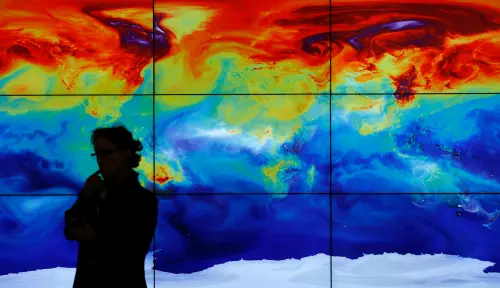This brief is part of the Brookings Blueprints for American Renewal & Prosperity project.
Fundamentally, climate change is a serious economic threat. As climate-related damages increase (e.g., from increasingly frequent extreme weather events), it is essential for corporations and governments to implement measures to mitigate climate change and its risks to the economic system. However, many companies have not even begun to recognize and deal with the economic and financial risks they face from a carbon-constrained, climate-disrupted future. While some stakeholders (e.g., investors, certain regulators) have started to grow more cognizant of these risks, their actions thus far have been inadequate to improve the climate resilience of a post COVID-19 economy in the U.S. Absent new climate change regulations or significant investor pressure, it is difficult to incentivize companies to undertake the timely and necessary investments needed to improve their climate resilience for the future.
In this context, the massive amounts of federal recovery aid disbursed to corporations due to the COVID-19 pandemic present an occasion to leverage federal funds already in use to advance our progress in addressing climate risks. Many other developed economies have already taken similar measures by incorporating climate provisions in their COVID-19 recovery packages. We argue that the U.S. should follow suit by using pandemic recovery funds to incentivize corporations to better confront their own climate risk exposure by attaching climate conditionality to relief for the private sector. In particular, we propose that:
- Corporations that receive COVID-19 relief should report on their exposure to climate risks and on their climate impact.
- Companies should be incentivized to implement an internal carbon pricing scheme through favorable terms for COVID-19 relief loans.
- Companies from certain carbon-intensive sectors should face additional climate-related restrictions.
Challenge
Climate change will fundamentally impact economic, political, and social systems around the world. As the physical effects of climate change become more visible and urgent, the economic damages from climate-related risks are starting to mount as well. Unfortunately, efforts by corporations and government entities in the U.S. to prepare for the impacts of climate change have been inadequate. For various reasons, including the long-term and global nature of climate change, the diffuseness of its impacts, the strong prevalence of climate denialism in the U.S. political system, and short-term business decision making, we have seen almost no significant climate legislation to improve the United States’ climate resilience and hardly any long-term sustained efforts by corporations to prepare for climate change. Firms in particular are not yet well prepared to deal with or even report their exposure to climate-related risks, although firms and investors have started pursuing such efforts more recently. For instance, while 93 percent of publicly traded firms in the U.S. (corresponding to $33.8 trillion in market value) were confronted with direct or indirect risks from climate change in 2016, only 12 percent of those companies divulged those risks publicly.
To increase the U.S. economy’s climate resilience, companies and governments will have to take significant action to mitigate the physical and transition risks of climate change. In this context, the current COVID-19 pandemic affords the U.S. the opportunity to mitigate the impact of two crises at the same time. Many entities, including leading economists, the International Monetary Fund (IMF), and the United Nations Environmental Program have argued for incorporating green measures into COVID-19 recovery packages. Kristalina Georgieva, IMF’s managing director, recently called for dedicating greater resources to climate action globally in the next COVID-19 recovery phase. Such efforts will have long-term impacts in shaping the future economy and deciding which companies and industries emerge economically viable out of this crisis. The efforts also involve substantial sums of money that will impact government budgets and limit the feasibility of spending similar sums of money in the future. The federal government has already allocated over $4 trillion to support the economic recovery and will likely invest even more. This money has so far been distributed to households through stimulus checks, to businesses through loans and bailouts, to state, local, and tribal governments through restricted aid, and through several other funds. By using the additional funds from future COVID-19 aid packages to improve climate resilience, the federal government can both promote a strong economic recovery and induce corporations to prepare for the coming threats due to climate change. This needs to be done intentionally, efficiently, and thoughtfully.
Many other countries and regions have already included substantial funding for climate mitigation in their COVID-19 recovery spending. The EU devoted 500 billion of a 1.8 trillion euro package to climate change efforts, explicitly centering climate resilience in its recovery strategy. Funding from the package will go toward renovating infrastructure to increase its climate resilience, increasing capacity for renewable energy, and boosting investment in electric vehicles and other modes of clean transportation. Moreover, Germany dedicated about one third of its stimulus plan to reducing emissions through investments in renewable power and electric vehicles, and other countries that are incorporating green measures in their COVID-19 recovery efforts include France, South Korea, China, Spain, and Italy.
Furthermore, climate measures have been incorporated in recovery efforts in prior crises as well. A paper by the World Resources Institute analyzed “green” stimulus spending during the financial crisis of 2008-09. The authors found that about $520 billion, or 16 percent of total global fiscal stimulus, was spent on green stimulus measures. China and the U.S. led these spending efforts in absolute terms, investing $218 billion (about 33 percent of its total) and $118 billion (12 percent of its total) respectively. In the U.S., green stimulus money was primarily directed toward renewable energy, energy efficiency, environmental preservation and conservation, and public transit. While COVID-19 stimulus efforts are still underway, the paper finds that spending on climate-related measures by major economies as a share of total stimulus is much smaller than the 2008-2009 shares. Furthermore, the U.S. lags behind most other developed economies.
Thus far, discussion surrounding the inclusion of climate provisions in COVID-19 relief has centered on using public stimulus funds to invest in climate resilient infrastructure and clean energy. This is an important component of building climate resilience, but it is not the only one. Another path that has received less attention is the option to build climate resilience among corporations by attaching conditions to recovery and relief money awarded to firms. Canada has pursued this goal by requiring climate disclosure from companies that receive economic aid, while several countries in Europe have attached climate conditions to aid for specific sectors. However, the U.S. has fallen short of imposing climate conditions on the trillions of dollars it has allocated toward the recovery.
Limits of historic and existing policies
To date, the federal government has authorized over $4 trillion in COVID-19 relief spending, primarily through the passage of the Coronavirus Aid, Relief, and Economic Security Act (“CARES Act”) in March and the Coronavirus Response and Relief Act in December.1 Most relief channels—including those for corporations—required very few conditions of recipients. For early relief efforts in the spring, this was necessary to ensure speedy passage given the overwhelming need for economic aid at the time,2 yet the lack of conditionality—specifically, climate conditionality—has continued in more recent relief packages. Moreover, a significant portion of COVID-19 relief has been granted to larger corporations without requiring any action on climate change in return. By failing to attach climate conditions to corporate aid, the U.S. government has forfeited the opportunity to use large sums of government funds to compel corporations to address their climate risk exposure at the same time. This stands in contrast to other developed nations that have combined COVID-19 aid with climate resilience measures. We discuss the shortcomings of several key relief channels directed at corporations in the U.S. below.
Paycheck Protection Program
The CARES Act of March 2020 established lending programs for small businesses (among many other efforts). A program that has received special attention is the Paycheck Protection Program (PPP), which provides potentially forgivable loans to small businesses to help them sustain operations and retain employees during the pandemic. Businesses with less than 500 employees are eligible to receive loans up to $10 million. If borrowers use the loan money on certain covered expenses tied to business operations and wages and salaries, then they are eligible to apply for loan forgiveness. While important for small businesses during this period, some loopholes in PPP’s provisions have allowed larger companies to solicit loans through the program, thereby receiving grants from the government without any significant conditions attached.
According to an analysis by the Wall Street Journal, among firms that received larger PPP loans of $1 million or more, the top four sectors are healthcare and social assistance, manufacturing, construction, and professional, scientific and tech services. Together, these sectors accounted for about 53 percent of companies approved for million-dollar-plus loans. Both manufacturing and construction sectors are carbon-intensive sectors, together accounting for about nine percent of U.S. carbon dioxide emissions. Even within the manufacturing sector, the top three industries receiving loans included metal and fabricated metal products, machinery, and chemical, plastics and rubber industries. All of them have significant climate impacts. Clearly, a large share of PPP funding went to sectors that have potential for better carbon performance, strengthening the argument for applying a climate lens to the loan disbursement efforts.
Corporate loans from the Federal Reserve
As part of its larger crisis response, the Federal Reserve (Fed) invoked Section 13(3) of the Federal Reserve Act which permits the Fed to lend to non-bank institutions in extraordinary circumstances. With Congressional support, it launched several new lending facilities for corporations in April 2020. This included the Main Street Lending Program (MSLP), designed to lend to small and medium-sized companies that were too large to qualify for PPP but too small to access the Fed’s other corporate credit facilities. Companies with up to 15,000 employees or $5 billion in annual revenue could borrow between $100,000 and $300 million from the Fed. In December 2020, Treasury Secretary Mnuchin announced that all 13(3) facilities would be terminated at the end of the year. Shortly after, a provision in the Response and Relief Act revoked the remainder of the funds that Congress had allocated to assist in Fed relief efforts, formally ended the 13(3) facilities, and forbid the Fed from using Section 13(3) to establish any identical programs in the future without Congressional approval.
Like PPP loans, the Fed’s corporate loans came with very few strings for borrowers. Corporate and MSLP borrowers faced restrictions on stock buybacks and dividend payments during the six-month payment deferral period. In addition, MSLP borrowers also faced restrictions on executive compensation and capital distribution. However, neither of these programs imposed the worker retention requirements mandated by PPP. Furthermore, neither imposed any conditions related to recognizing or lessening one’s climate impact.
Aid for the fossil fuel industry
In April and June, the Fed adjusted its MSLP terms after repeated lobbying from fossil fuel companies. The MSLP had been designed to assist companies who had to take on additional debt in response to the pandemic. However, many fossil fuel companies had been heavily indebted prior to the pandemic and lobbied for assistance in servicing their debt obligations. The industry advocated for increased maximum loan amounts, relaxed leverage limits, and the ability to refinance existing loans through the Fed. In April, the Fed launched its Main Street Priority Lending Program, which allowed companies whose existing debt disqualified them from other Main Street programs to apply for new loans through the Fed, as well as to refinance existing loans. As of December 2020, 13 percent of loans from the MSLP have gone to fossil fuel companies compared to just one percent to clean energy companies. Additionally, more than 5,600 companies in the fossil fuel industry received loans from the PPP program. BailoutWatch, a nonprofit that is tracking bailout dollars poured into the fossil fuel industry, estimates that between $10 billion to $15 billion have been spent in providing relief to the fossil fuel industry through tax cuts, PPP lending, and the MSLP.
Aid for the airline industry
Airlines have been especially hard hit by the pandemic. The slowdown of vacation and business travel and the health concerns associated with flying have sharply reduced the demand for air transportation. As a result, airline losses for 2020 are expected to exceed $35 billion. Employment levels have already fallen dramatically, with companies such as Delta Air Lines and United Airlines furloughing or laying off over 30 percent of their workforce. To counter the economic effects of the pandemic, the air transportation industry received over $60 billion in relief in 2020 and industry bodies are calling for additional support. Given such significant aid, airlines’ climate impact cannot be ignored even as the need to save the industry during the pandemic is clear and indisputable. Air transportation accounts for 2.4 percent of global carbon emissions. A one-way flight from London to New York produces 986 kg of carbon dioxide per person—more than the average resident produces per year in 56 countries. While airlines have made some modifications in order to improve fuel efficiency, these changes have not been large enough to offset the projected rise in demand for flights over the coming decades. One study estimates that airline traffic has increased four times faster than fuel efficiency has improved. Thus far, the government has not attached any environmental impact conditions to relief for airlines. While the airline industry is indeed struggling and will likely receive more funds, it is important to push it towards more long-term climate resilience through the bailouts.
Policy recommendations
Our central policy recommendation is that the federal government should incorporate climate resilience considerations in the disbursement of future COVID-19 loans and grants to large corporations. A sizeable share of relief has been and will continue to be dedicated to firms to help them maintain business operations in the face of the COVID-19 pandemic. While these goals should remain the core tenets of COVID-19 relief, now is the time to apply a climate lens to recovery efforts as well. We identify three ways below in which the federal government can do this meaningfully and carefully without hampering the short-term recovery of companies. As many small businesses may not have the capacity to comply with some of the provisions we propose, we limit the scope of our recommendations to loans or grants of greater than $1 million that are intended for larger corporations.
Climate-related reporting
Companies that receive COVID-19 funding should be required to report on their climate impact and their exposure to climate-related risks. These data would aid the companies, policymakers, investors, and other market participants. First, it forces the companies to actively think about their climate impacts and financial exposure to climate-related risks and plan accordingly. Second, financial regulators and policymakers can tap into these relevant data to shape future policy. This is especially timely to support and accelerate the Biden administration’s ambitious climate policy agenda. Finally, these data will help aid decisions for market participants, such as climate-conscious consumers and investors who seek to mitigate climate-related risks or build sustainable portfolios.
Disclosure of climate-related financial risks helps markets and regulators understand systemic risks comprehensively. As the Task Force on Climate-related Financial Disclosures (TCFD) notes, financial markets need “clear, comprehensive, high-quality information on the impacts of climate change” to price climate-related risks and opportunities and facilitate a smooth transition to a low-carbon economy. Financial institutions, regulators, and non-profit organizations have begun to seriously consider and act on disclosure. TCFD has made significant progress towards designing a standardized framework. The federal government should embrace this momentum and incorporate climate-related disclosure provisions for companies receiving COVID-19 related relief. This would serve as a great vehicle to pilot a more standardized climate disclosure with the intention of extending the framework and lessons learned to the broader economy later. Canada has already taken steps in this direction. As a part of its Large Employer Emergency Financing Facility, which provides short-term liquidity assistance to companies with more than 300 million Canadian dollars in revenue, Canada will require businesses that receive COVID-19 aid to disclose their climate impacts and make environmentally sustainable decisions. The terms of the loan state that the recipients will have to publish “an annual climate-related financial disclosure report, highlighting how corporate governance, strategies, policies and practices will help manage climate-related risks and opportunities.” These reports must be consistent with the recommendations of the TCFD. Additionally, the companies will have to identify opportunities in their future operations to contribute to Canada’s commitments to the Paris Agreement.
Moreover, the federal government should encourage corporations to report on their greenhouse gas emissions. In 2009, the Environmental Protection Agency (EPA) instituted mandatory reporting of greenhouse gas emissions for all facilities that emit more than 25,000 metric tons of carbon dioxide annually. Approximately 8,000 facilities are subject to this requirement, which encompasses power plants, petroleum and natural gas extraction sites and refineries, chemical producers, waste management processers, and other industries. The program was designed to focus primarily on the oil and gas industry and centers on the direct emissions produced by each facility. We propose that companies that receive federal aid should adhere to a modified version of this program. Any large corporation that receives COVID-19 relief funds moving forward should conduct a full accounting of the company’s direct and indirect emissions and report the findings to the EPA. Further details of the program should be guided by well-established standards such as those laid out in the Greenhouse Gas Protocol. This would help the businesses identify strategies to reduce their emissions, increase transparency in reporting, and help provide policymakers with invaluable data for designing frameworks and making policy decisions.
Internal carbon price
Internal carbon pricing has numerous advantages both for corporate strategy and for achieving environmental goals. By incorporating a carbon price into business decisions, companies can better prepare for future environmental regulation and reach their own climate goals. As investors and consumers demand more climate-friendly behavior from companies, the popularity of internal carbon pricing has grown. In 2019, nearly 700 major companies used internal carbon pricing, and 900 others were expected to implement a carbon price in the coming two years. Internal carbon pricing also has advantages for governments: companies’ internal carbon pricing can work in tandem with environmental regulation to reduce emissions and can reduce obstacles to enacting stricter environmental regulations.
Given the benefits of internal carbon pricing both for reducing emissions and for improving corporate strategy, we propose using COVID-19 relief funds to incentivize businesses to establish an internal price on carbon. Companies that commit to setting a sufficiently high internal carbon price in the five years after receiving aid should be eligible for more favorable loan terms. For instance, corporations that borrowed from the Fed’s MSLP are currently subject to adjustable interest rates and must repay their loan within five years. If a similar program is launched in the future, companies that provide proof of an internal carbon price before their loan matures should receive an interest rate reduction. More broadly, other lending programs from executive agencies and legislative action should incorporate similar incentives.
Based on case studies of companies that currently use internal carbon pricing (such as these reports from Yale and from C2ES), regulators should set minimum standards for carbon pricing schemes that companies have to meet in order to qualify for interest rate reductions. There are many different forms that internal carbon pricing schemes can adopt. Companies can choose to use a “shadow price” on emissions when making future investment decisions or can levy an internal “carbon charge” on business units based on their emissions. Companies also must choose how much to charge for carbon emissions, how often to levy this charge, and how to use any funds raised by an internal carbon charge. Corporations should have some flexibility to implement a carbon pricing scheme that fits their business operations. However, regulators should take care to ensure that companies do not take advantage of these incentives by implementing ineffectual carbon pricing. To start, we propose that the price companies set should be at least $20 per ton of carbon, that a portion of funds raised through the carbon pricing scheme should be earmarked for investments in further emission reductions, and that the internal pricing scheme should incorporate both a shadow price and a carbon charge.
Sector-specific provisions
Certain sectors have received a disproportionate amount of COVID-19 relief. For some, the need for aid is an obvious consequence of the nature of the pandemic. For instance, air passenger demand measured by revenue passenger kilometers declined by 94.3 percent year-on-year in April 2020, necessitating government intervention if airlines were to survive. However, other sectors which have received considerable aid, like the fossil fuel industry, were already struggling prior to the pandemic. Regardless of the source of need for aid, many industries that have received significant relief are also carbon-intensive. Policy provisions tailored to each of these sectors that push them toward more climate-friendly outcomes should be an important element of future loans and grants for these industries.
Airlines: commit to reducing emissions and increasing sustainable fuels
Any future bailout of the airline industry should be tied to climate resilience provisions. The French government has set precedent for this by announcing “climate conditions” in bailing out its national carrier Air France-KLM via a loan of 7 billion euros. The conditions for Air France-KLM include improving the efficiency of its fleet, halving its carbon dioxide emissions by 2030 compared with 2005 levels, and burning a minimum of two percent alternative fuels in 2025. However, these conditions are not legally binding. A version of the CARES Act had similar climate provisions, requiring airlines to halve carbon emissions by 2050 and start offsetting those emissions in 2025 as well as $100 million over five years for research and development of more sustainable aviation fuels. Unfortunately, these provisions were eliminated during negotiations.
We propose to build on these examples by incorporating similar conditionality into future airline aid. In order to receive relief funds, airlines should adhere to the reporting and internal carbon pricing requirements we outline above by 2025. We also propose that airlines should be held to specific requirements designed to reduce their emissions. To receive aid, airlines should convert to using a minimum percentage (at least two percent) of sustainable aviation fuels by 2025, a percentage that potentially can increase in the years that follow. Airlines also should commit to reducing emissions in other ways, such as through charting more efficient flight paths. Unlike previous proposals, we argue that all these requirements should be legally binding and that airlines should be subject to fines or other consequences if they fail to meet these requirements.
Auto sector: boost energy-efficient fleets and electric vehicles
While the U.S. auto sector suffered in the early months of the pandemic, it has been on a path of recovery. However, the path forward remains uncertain as the nature of commuting transforms during and after the pandemic. These uncertainties will determine whether the auto sector will require stimulus in the future and what form this stimulus will take. In any case, the auto sector is central to planning for a climate-resilient future and so any stimulus should incorporate a strong nudge towards cleaner transportation. Lending to producers should come with conditions encouraging the production of energy-efficient fleets beyond what is mandated by existing regulation. Germany, France, Italy, and Spain have all announced auto sector stimulus packages encouraging the purchase and production of low- or zero-emission vehicles. Two French automakers, Renault and PSA, received bailouts on the backs of pledges to increase the production of green vehicles.
Fossil fuel industry: no more aid
The coal, oil, and gas industries should not receive any additional bailouts. First, these industries generate disproportionate environmental impacts, and therefore the environmental consequences of supporting these industries outweigh any short-term economic benefit. Second, investments in fossil fuel industries are becoming increasingly risky. The coal, oil, and gas industries were already struggling before the pandemic, marked by falling employment, poor stock market performance, and increasing bankruptcies – problems that are likely to persist even post-pandemic as we transition towards a low-carbon economy. Other work highlights that fossil fuels are a suboptimal investment with parts of industry awash in heavy debt. Moreover, propping up these companies, which contribute significantly to global climate change, would accelerate climate-based risks to the financial system. Finally, as Sarah Bloom Raskin notes, such investment sends a false price signal to the industry about where capital should be allocated. Instead, any stimulus money should focus on supporting a swift transition to a low-carbon economy, which would not only mitigate climate resilience but also incorporate certainty and stability in the financial system.
Conclusion
The economic challenges created by the COVID-19 pandemic are large, but they present a key occasion to mitigate the cost of the climate crisis that has already arrived. We must ensure that any future relief funds allocated toward economic recovery not only address the current costs of the pandemic, but also guard against the worst impacts of climate change. To this end, we advocate that the government encourage businesses to evaluate and alleviate their own climate risk by attaching conditionality to recovery efforts. By using the promise of economic relief to incentivize businesses to report on their climate risk and impact, implement an internal carbon pricing scheme, and address climate impacts that are specific to their sector, we can encourage companies—and by extension the larger economy—to build resilience against climate change.
-
Footnotes
- This figure does not account for additional spending from the Federal Reserve in response to the crisis, which so far has amounted to almost $6 trillion.
- The U.S.’s unique partisan divide on climate change prevented the inclusion of climate provisions in the initial stimulus packages, but this was not the case in many other countries. Governments in the E.U., Canada, and other countries were able to address climate change in their initial stimulus packages because, unlike in the U.S., climate change is a relatively less partisan issue and plays a smaller role in impeding the passage of legislation.
The Brookings Institution is committed to quality, independence, and impact.
We are supported by a diverse array of funders. In line with our values and policies, each Brookings publication represents the sole views of its author(s).










